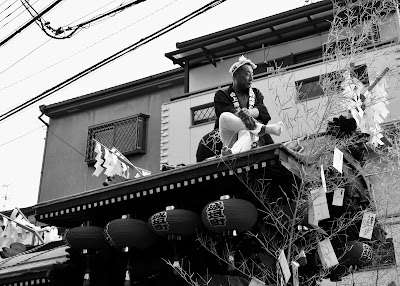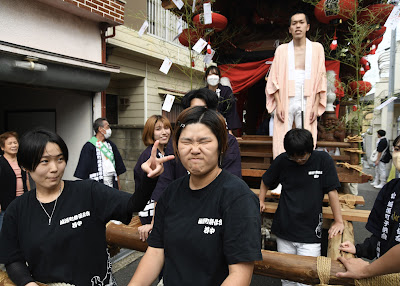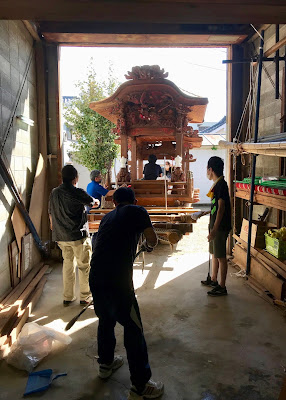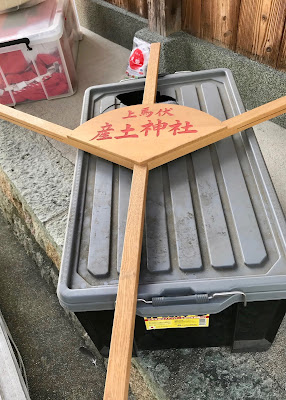Check it out!
July 17, 2024, 18:00-19:30
Room 402, 4F, Building 2
Sophia University, Tokyo
Abstract:「The Tachinomi Project」is a visual ethnography based upon the con- vergence of social science research and contemporary art. The project began with long-term participant-observation and a photographic exhibition featuring a 40-year-old tachinomiya (standing drink bar) in Osaka called Tenbun. The study sought to explore photography in public spaces, privacy and image ethics while showcasing a “grimy” (Farrer 2019) and stimulating atmosphere with colorful characters including the shop owner, employees and regular customers. The interactions with Tenbun collaborators and gallery audience at the exhibition became the first of several post-fieldwork encounters, leading to the re-positioning of the research into wider social and academic contexts during and after the COVID 19 pandemic. This present account utilizes reflexivity, autoethnographic vignettes (Stevens 2013) and photography to explore the intersections of the sensory (Pink 2013 [2009], multimodal (Collins et al. 2017), and ba (Kajimaru et al. 2021) of Tenbun and other eating and drinking establishments.
Click here for some background on the project.
Yoroshiku onegai shimasu.
Explorations and experiments in visual representations - multimodality, sensory ethnography, reflexivity, autoethnographic vignettes, ethnographic photography and ba...

Showing posts with label multimodality. Show all posts
Showing posts with label multimodality. Show all posts
Wednesday, July 10, 2024
A call out to my friends and colleagues, visual and multimodal anthropologists, cultural anthropologists, photographers & sake and tachinomiya lovers in Tokyo and the surrounding area; VAoJ is making a rare appearance in Tokyo for a special lecture:「The Intersections of the Sensory, Multimodal and Ba: The Tachinomi Project」Please share and spread the word...
Sunday, July 7, 2024
Standing Drink Bar「Tenbun」Old Boys Reunion 立ち呑みの居酒屋「天文」O.B. 会
We were on the bus, traveling through the borderlands between Osaka and Kyoto Prefectures when the imojōchū began to kick in.
We had just finished an hour-and-a-half of “all you can eat/all you can drink” at a traditional izakaya banquet. This kind of gluttonous binging and imbibing pushes participants, especially those on a pensioner’s budget with little left over after pachinko and horse race betting activities, to extremes, to make sure they get their money’s worth. Since the food turned out to be only standard fare, we concentrated on the drinking: beer, sake (nihonshu) and sweet potato distilled liquor (imojōchū; usually 25-35% alcohol). A half hour in we were getting livelier and louder, and receiving dirty looks and disapproving frowns from the shop staff and other customers. Our severs were stingy, only allowing us to order a new drink after giving up the empty vessel from the previous beverage. Some of us countered this policy by pouring alcohol into PET bottles and plastic bags for secret take-out. We drank steadily until the last order. Somehow, we all were able to stand, pay our portions of the bill, use the toilet and stumble to the return bus without too much trouble. What started out as a gathering of long-lost friends taking a short trip on a privately rented bus with quiet small talk of recent illnesses, hospitalizations and deceased drinking companions, was now a drunken cacophony of laughing, shouting, quiz games and attempts at singing enka. We exited the bus at the Keihan Kuzuha train station, took a memorial photo and made our way to the shopping arcade, formerly the aged, everyman Norengai (“Noren Street”), home to several traditional eating and drinking establishments. Recently this arcade was gentrified and renamed “El Kuzuha.” The older shops, many of which closed due to COVID-19, were conveniently replaced with fashionable chain restaurants. We wandered through the corridors until deciding on an acceptable pub for our continued revelry. This post-fieldwork encounter chronicles a reunion of the owner and regular customers (the O.B.s or Old Boys) of a 40-year-old tachinomiya (“standing drink bar”) in Osaka called Tenbun, that closed in 2020.
Imojōchū has a strong taste and pungent smell, even when mixed with ice and water. For me, drinking it results in a contemplative body buzz; but when combined with beer and sake, the odoriferous contemplation turns into a gregarious stupidity. Nonetheless, this can be fun with the right people at the right time.
The Tenbun O.B. reunion was such a righteous group and occasion. After all, we were trying to resurrect something. Not a specific time, place, feeling, memory or dream. Something more, perhaps a sort of fluid liminal communitas (and I do not use these terms lightly) that, in the past, we could enter at will, or at least between Tenbun’s usual business hours Monday through Saturday. The hour of day (or night), people, circumstances, jokes, arguments, daily specials and drinks always varied and at the same time enmeshed to create this familiar something. Looking back, I can see how we took it for granted, the longest-term customers for as long as 40 years. But now we missed it. And we wanted it back, even if only for this one day.
Of course, none of the O.B.s explained the reunion in these terms, except for the over-analyzing anthropologist with a camera, soaking in another post-fieldwork experience. Ba…
To be continued…
We had just finished an hour-and-a-half of “all you can eat/all you can drink” at a traditional izakaya banquet. This kind of gluttonous binging and imbibing pushes participants, especially those on a pensioner’s budget with little left over after pachinko and horse race betting activities, to extremes, to make sure they get their money’s worth. Since the food turned out to be only standard fare, we concentrated on the drinking: beer, sake (nihonshu) and sweet potato distilled liquor (imojōchū; usually 25-35% alcohol). A half hour in we were getting livelier and louder, and receiving dirty looks and disapproving frowns from the shop staff and other customers. Our severs were stingy, only allowing us to order a new drink after giving up the empty vessel from the previous beverage. Some of us countered this policy by pouring alcohol into PET bottles and plastic bags for secret take-out. We drank steadily until the last order. Somehow, we all were able to stand, pay our portions of the bill, use the toilet and stumble to the return bus without too much trouble. What started out as a gathering of long-lost friends taking a short trip on a privately rented bus with quiet small talk of recent illnesses, hospitalizations and deceased drinking companions, was now a drunken cacophony of laughing, shouting, quiz games and attempts at singing enka. We exited the bus at the Keihan Kuzuha train station, took a memorial photo and made our way to the shopping arcade, formerly the aged, everyman Norengai (“Noren Street”), home to several traditional eating and drinking establishments. Recently this arcade was gentrified and renamed “El Kuzuha.” The older shops, many of which closed due to COVID-19, were conveniently replaced with fashionable chain restaurants. We wandered through the corridors until deciding on an acceptable pub for our continued revelry. This post-fieldwork encounter chronicles a reunion of the owner and regular customers (the O.B.s or Old Boys) of a 40-year-old tachinomiya (“standing drink bar”) in Osaka called Tenbun, that closed in 2020.
Imojōchū has a strong taste and pungent smell, even when mixed with ice and water. For me, drinking it results in a contemplative body buzz; but when combined with beer and sake, the odoriferous contemplation turns into a gregarious stupidity. Nonetheless, this can be fun with the right people at the right time.
The Tenbun O.B. reunion was such a righteous group and occasion. After all, we were trying to resurrect something. Not a specific time, place, feeling, memory or dream. Something more, perhaps a sort of fluid liminal communitas (and I do not use these terms lightly) that, in the past, we could enter at will, or at least between Tenbun’s usual business hours Monday through Saturday. The hour of day (or night), people, circumstances, jokes, arguments, daily specials and drinks always varied and at the same time enmeshed to create this familiar something. Looking back, I can see how we took it for granted, the longest-term customers for as long as 40 years. But now we missed it. And we wanted it back, even if only for this one day.
Of course, none of the O.B.s explained the reunion in these terms, except for the over-analyzing anthropologist with a camera, soaking in another post-fieldwork experience. Ba…
To be continued…
Monday, October 24, 2022
2022 Fall Festival - I'm feeling like monochrome...
For (a lot) more information about the fall festival:
「Neighborhood Autumn Festival in Japan: A Multimodal Visual Ethnography and Performance」
https://visualanthropologyofjapan.blogspot.com/2020/05/special-multimodal-bonus-resources-and.html
「Neighborhood Autumn Festival in Japan: A Multimodal Visual Ethnography and Performance」
https://visualanthropologyofjapan.blogspot.com/2020/05/special-multimodal-bonus-resources-and.html
Sunday, October 23, 2022
2022 Fall Festival - Day Two
See yesterday's post for Day One Photos. Here's Day Two... I'm already looking forward to next year!
 For (a lot) more information about the fall festival:
For (a lot) more information about the fall festival:
「Neighborhood Autumn Festival in Japan: A Multimodal Visual Ethnography and Performance」
https://visualanthropologyofjapan.blogspot.com/2020/05/special-multimodal-bonus-resources-and.html
 For (a lot) more information about the fall festival:
For (a lot) more information about the fall festival:
「Neighborhood Autumn Festival in Japan: A Multimodal Visual Ethnography and Performance」
https://visualanthropologyofjapan.blogspot.com/2020/05/special-multimodal-bonus-resources-and.html
Saturday, October 22, 2022
2022 Fall Festival - Day One
After two long years of COVID-19 restrictions, we were finally able to hold our neighborhood fall festival this year. The program was cut back a bit - no night festival or mochi maki and an abbreviated course. Rain hampered things on the second day no we couldn't have our usual yaki niku barbeque. But still, it was great to see my friends after so long and push-pull the danjiri throughout the neighborhood. My activities were cut back as well due to injury. I went back to being the event photographer rather than a danjiri pusher. But we were lucky to have a group of student volunteers from a nearby college - we really couldn't have done it without them. So, here are the Day One Photo Offerings...
For (a lot) more information about the fall festival:
「Neighborhood Autumn Festival in Japan: A Multimodal Visual Ethnography and Performance」
https://visualanthropologyofjapan.blogspot.com/2020/05/special-multimodal-bonus-resources-and.html
Sunday, October 10, 2021
秋祭 / Fall Festival 2021 (pt.1): canceled again due to COVID-19, but a few of us got together in the morning to drag the danjiri out of storage and clean it for the the first time in two years; it was good to see my friends again and participate in other activities at the shrine in the afternoon (to be continued...)
Last year: https://visualanthropologyofjapan.blogspot.com/2020/10/no-fall-festival-this-year-danjiri.html
All you need to know about the fall festival through the years! SPECIAL MULTIMODAL BONUS RESOURCES AND PHOTOS FOR「Neighborhood Autumn Festival in Japan: A Multimodal Visual Ethnography and Performance: https://visualanthropologyofjapan.blogspot.com/2020/05/special-multimodal-bonus-resources-and.html
All you need to know about the fall festival through the years! SPECIAL MULTIMODAL BONUS RESOURCES AND PHOTOS FOR「Neighborhood Autumn Festival in Japan: A Multimodal Visual Ethnography and Performance: https://visualanthropologyofjapan.blogspot.com/2020/05/special-multimodal-bonus-resources-and.html
Subscribe to:
Posts (Atom)




























































